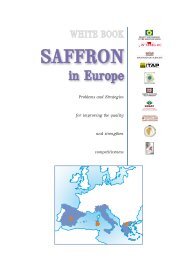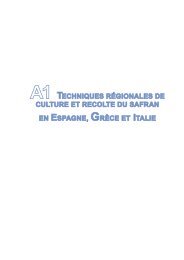Annex White book.pdf
Annex White book.pdf
Annex White book.pdf
You also want an ePaper? Increase the reach of your titles
YUMPU automatically turns print PDFs into web optimized ePapers that Google loves.
A3.2.1 Cleaning: removal of foreign parts and flowerresiduesThe term flower residues refers to: petals, free stamens (separatedfrom the stigma), flower foot, pollen and ovary parts of Crocus SativusL. (ISO TS-3632-1: 2003). Foreign parts are: leaves, stems, dry weedsand various other plant residues different from those described above,belonging to the flower Crocus Sativus L. (ISO TS-3632-1: 2003).In Sardinia (producers – traders), cleaning of foreign parts takesplace during separation of the stigmas.In Western Macedonia (producers – traders) a special bench is usedfor visual control of foreign parts (small stones, hair, leaves, soil, insects,plastic parts etc). Saffron is then placed on a special shaking sieve forfive seconds maximum in order to remove the pollen.In Castile-La Mancha (packer – distributor), cleaning of foreign partstakes place by hand, with great care so as not to break any stigma– this task increases labor costs. Some packers perform tests on variousconcepts to mechanize this procedure but the achieved results arenot very satisfactory.A3.2.2 Disinfection processIn Castile-La Mancha many packers apply various permissible disinfectantson the product, in order to prevent insect growth, given the factthat the use of methyl bromide and ethylene oxide is forbidden nowadays.In Sardinia and Western Macedonia producers – traders do not performany disinfection procedure.A3.2.3 Humidity controlThe humidity added to the product must be controlled in order tomaintain legal standards and prevent mould and fungus developmentthat weakens the coloring agents. The humidity levels are higher for saffronthreads than for saffron powder.In Sardinia, producers – traders do not perform controls on humidity.Analysis carried out on samples show that humidity levels do not exceed10 %.In Western Macedonia (producers – traders) saffron is delivered to the“Saffron Cooperative” with humidity levels at 11,5 %. If humidity exceedsthis level, the product must be dried in a special furnace, owned by thecooperative.In Castile-La Mancha (packer – distributor) it is very common to lightlywet the stigmas during production of the saffron threads. This makessaffron softer and thus more resistant to breakage.133




